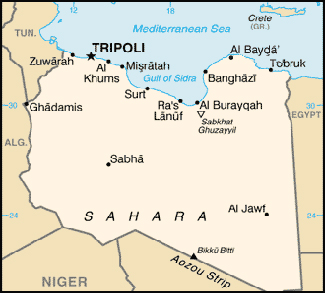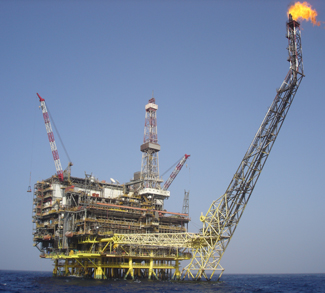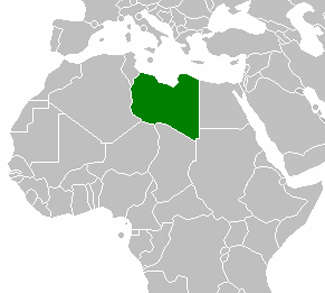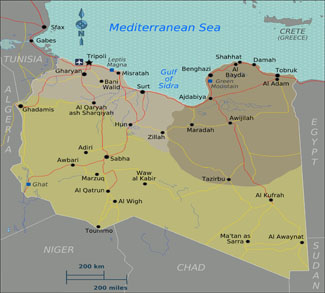Libya is a country located in Northern Africa that borders the Mediterranean Sea. Until the 1950s, it was regarded as another poor African state, but the discovery of oil greatly increased its wealth, turning it into one of the richest African countries and also increasing its significance in the eyes of Western Powers. Emerging from the colonial era, Libya struggled with independence and experienced almost two decades of fragile stability as the United Kingdom of Libya from 1951-1969. However, the September 1st Revolution of 1969 saw Colonel Muammar Gaddafi seize power in a bloodless coup d’état. Gaddafi’s Libya lasted over 40 years, though recent events have seen the dictator ousted and the ascendance of the constituent assembly-cum-parliament General National Congress (GNC)
Benghazi was shaken last week by a massive car bombing, an event that was followed by hundreds of people taking to the streets to vent their frustration at a government that has not been able to fill the security vacuum opened by the removal of Gaddafi. For a sense of where Libyan politics are headed if the country’s present instability continues, one must look to the historical power centers, such as Tripolitania and Cyrenaica, as well as the geopolitical factors of bordering states and resource distribution. Such factors may determine if Libya eventually splits into two politically autonomous territories; namely, Tripolitania and Cyrenaica.
A Brief History and the Geography of Libya
Libya’s tribal system has been an enduring feature of its culture of resisting imperial influence. Throughout Libya’s history, Libyans saw their own people as authority figures. Tribal families and heads were regarded as the country’s elite. Rather than believing in a nation state, the tribal system categorized Libya into local governments, headed by tribal leaders. Such leaders, in turn, would exercise their own patronage system to maintain and exert influence (which was of greater importance after the discovery of oil). The local and familial aspects of the tribal system, by their very nature, did not include a sense of national unity. The primacy of tribal belief thus mitigated certain effects of imperialism. While Italy attempted to disrupt and divide the tribal system, they were not very successful. Europeanization was resisted, and Libyan elites who worked with Italian masters retained cultural links with their fellow Libyans. Italian colonial rule ended in 1911, and Arab Muslim culture reemerged rapidly in full strength. Nonetheless, Gaddafi himself disliked tribal roots, viewing such a system as antiquated and an obstacle to modernization. Hence, tribal boundaries were worked into new zones that attempted to weaken tribal links and local patronage systems in order to prioritize a more modern belief of (political) competence through education of the elites. Government attempts to abolish the tribal system were, however, resisted. Ultimately, Gaddafi was forced to maintain his power through the manipulation of tribal allegiances, all the more significant because of the small size of Gaddafi’s own Gaddafa tribe.
Gaddafi’s patronage network was structured around both security and the nation’s resources. Given his own tribe’s small size, Gaddafi had to compensate and thus used members of Libya’s largest tribe, the Warfalla, as security personnel. In addition, the Zuwayya tribe in the oil-rich South would have had to be placated in various ways (i.e. through being granted a privileged status in Gaddafi’s patronage system) due to their proximity to resources. This importance became clearer during anti-Gaddafi protests, when Zuwayya members threatened to withhold oil supply due to Gaddafi’s violence against protestors. In addition, Gaddafi’s treatment of protestors also cost him support of the Warfallas, a major security loss.
Geographically speaking, Libya has three regions of significance to both political and agricultural stability. Tripolitania and Cyrenaica have historically been political rivals. Both partnered with Axis and Allied powers respectively during the Second World War. In addition, tension increased considerably post-independence when Western powers supported the installation of King Emir Sayid Idris, a Cyrenaican, causing much bitterness in Tripolitania. When Gaddafi seized power in 1969, feelings of bitterness and joy were reversed. Mutual hostility has thus prevented a sense of national unity, further enforced by the geographical layout of the Gulf of Sirte, which creates physical distance between the two regions, symbolizing their mutual callousness and feelings of being more Tripolitanian or Cyrenaican than united Libyans. Finally, the region of Fezzan holds some importance for its pastoral culture (and thus minor agricultural capabilities).
However, Fezzan’s agrarianism is not enough to feed Libya’s population. As one critic explains, most of Libya is composed of arid land, which cannot sustain plant life or the growth of crops. The coast is the only area with less dryness. However, waves from the Mediterranean Sea frequently deposit salt on the coast, killing plant life and preventing the possibility of agriculture. Consequently, Libya is forced to import food, and it is therefore vital that the production of their resources resume forthwith. It is likely that for long-term economic growth, resumption of resource production will not be enough. As resources such as oil and gas must be exported, political stability will be needed to convince foreign companies to invest in the Libyan market.
Resources
With the discovery of oil in 1959, Libya became one of the wealthiest African states. Having been privy to Axis/Allied politics during the Second World War, the discovery of oil piqued Western interest in Libya more than ever, and Libya became another playing field for war games between the US and USSR. The Sirte Basin provides 80% of Libya’s oil output. With the largest proven oil reserves in Africa, oil is a major export good and source of income, with up to 1.5 million barrels exported on a daily basis. In addition, many critics argue that Libya remains underexplored, meaning that there is a potential for greater oil wealth. Further, Libyan oil often contains low sulfur traces, important to oil companies and exporters wishing to comply with stringent sulfur emission laws in Europe, Libya’s largest market. However, Libya’s biggest export is also significant in the domestic energy market, with oil dependence as high as 72%. Naturally, Libya must free up more oil for exportation in order to maximize state profits. Hence, the country is attempting to expand its use of gas (currently representing 28% of total domestic energy consumption) and is also experimenting with solar power in rural areas to reduce oil use. A balance between controlling the price of oil and domestic profits and maintaining positive relations with international oil companies has characterized Libya’s approach in the past.
As recently as 2005, however, the Libyan government changed the conditions of partnerships with international oil companies, limiting the profits such companies will receive. Previously, oil companies had enjoyed profit shares of up to 49%. Under the 2005 changes, this share has been reduced by up to half, and in some cases, oil companies are only granted an extension of their license to explore and profit from Libyan oil if they commit to further financial investment into the Libyan oil sector. This shift in attitudes from prioritizing positive relations with international oil companies to reducing their profits so as to increase state shares reveals how Libya now considers itself a well-established oil state (thus granting it greater control over its share of oil profits). Furthermore, the demands of reinvestment made on foreign oil companies illustrates how Libya both recognizes the importance of exportation as an almost sole source of profit and the potential for increased oil wealth through further exploration. Indeed, the latter likely explains why the state’s National Oil Company expects oil exploration to be undertaken by all oil companies operating in Libya.
Libya’s secondary natural resource is gas, which is becoming a significant good for both exportation and domestic energy consumption. As of 2011, Libya’s proven gas reserves were estimated at 54.7 trillion cubic feet. Though the second-lowest figure when compared to the rest of Africa, it is estimated that further exploration will see it rise considerably. Given Libya’s wish to decrease oil dependence, it is no surprise that gas production has steadily increased. By 2011, gas accounted for almost half of electricity production. While this figure does show an attempt to reduce oil dependence, gas use is still split between electricity generation and the use of gas to enhance oil recovery. Naturally, this split illustrates the difficult balance between reducing oil dependence through gas consumption and increasing oil production to increase oil exports. The difficulty of this balance, together with frequent project delays (exacerbated by Gaddafi’s downfall and subsequent turmoil) has limited the utility of gas and will likely continue to do so until the Libyan state is stable enough to focus on long-term state building and maximizing gas production through prompt project startups, both for domestic gas consumption and for increasing oil recovery and thus oil exportation.
The Geography of Resource Exportation
It is no coincidence that European states are the main recipients of Libyan oil. Historically, Libya’s proximity to Europe has allowed European powers to attach greater importance to Libyan oil than oil from the Arab world. Proximity translated into lower transportation costs and, more importantly, all pipelines ran directly across Libyan territory, a luxury geographically impossible with pipelines running from Arab Gulf states to Europe. Further, Libyan oil may be transported directly from Libya to Europe, with Sicily as the main entry point. The advantage of such direct transportation was highlighted by the closure of the Suez Canal shortly after the 1967 Middle East War. The closure severely affected oil transport routes from the Middle East to Europe. The importance of direct transportation has also been considered by Libya’s gas industry, with the construction of the Greenstream pipeline. Operational since 2004, the pipeline provides a direct gas route from the Libyan coast to Sicily and from Sicily to Italy’s mainland.
Finally, it is worth mentioning Sicily’s proximity to Libya. Geographically speaking, Italy is one of the main entry points of Libyan exports. This proximity symbolizes both Italy’s former imperial ties to Libya, but also current Italian-Libyan relations. Italy is the largest recipient of Libyan oil, and also has close commercial ties with Libya through Eni, Libya’s largest foreign oil producer. Eni has operated in Libya since 1959, and in 2009, the Libyan government invested in the Italian company, granting them greater influence in Europe. Prior to this move, Libya already had a significant stake in Europe through Tamoil, its overseas oil representative. Tamoil has allowed Libya to engage in direct distribution and refining of its products throughout Europe, including in Italy and Switzerland. Given Libya’s investment in Eni, one might say there is now an historical reversal from Italian imperialism to Libya having a commercial interest in its former master. In addition, Libya’s financial stake in Europe reveals how Europe’s own perception of Libya as Africa’s resource capital is not solitary. On the one hand, some critics may argue that Libya’s interest in Europe is simply a way of further bolstering its own resource exportation, and thus Europe’s interpretation of Libya purely as a resource market. On the other hand, Libya’s penetration into European markets and distribution may be seen as a form of reverse-imperialism, especially given Libya’s investment in Eni, an Italian company.
Actors’ Interests and Subsequent Interpretations
Some critics prioritize the importance of perceptions by both internal and external actors with regards to Libya’s geopolitical layout. Actors’ interests will often influence their attached interpretations of Libya that may not consider e.g. historical or cultural factors. Internal actors, however, are more likely to consider historical and cultural factors, and it is for this reason that the National Transitional Council (NTC), Islamist militants and Gaddafi himself placed symbolic value on the small town of Sirte, Gaddafi’s birthplace. Until its fall on October 20th, 2011, Sirte was regarded as a symbol of Gaddafi’s strength (and that of his supporters). Indeed, the fact that Gaddafi was found hiding in Sirte reveals the degree of personal importance the deceased dictator attached to his town and tribe, despite the small size of the Gaddafa, which, due to its size, was unlikely to afford him much protection. Such internal significance is in stark contrast to the NATO’s imposition of a no-fly zone and subsequent strategic bombing, which has focused only on Libya’s resources as being of significant value.
In addition, one must take into account other recent events in the Middle East, for example the revolutionary movement in Egypt and subsequent overthrow of President Hosni Mubarak. This revolution was itself considered a response to the Tunisian uprising against President Zine El Abidine Ben Ali. Both the revolutions in Egypt and Tunisia can be considered as causing a domino effect that spilled over into Libya. Given the fact that Libya borders both countries, with Egypt on one side and Tunisia on the other, a domino or spillover effect is quite likely. In addition, being ‘surrounded’ by countries in the midst of revolution likely meant that Libya would not be protected from potential spillover effects. Had, for example, only Tunisia engaged in an uprising (but not Egypt in turn), a spillover effect may have been limited by Tunisia’s small size relative to that of Libya’s. However, one must remember that Libya’s aridness allows for only limited areas of habitation, with population densities of approximately 50 persons per square kilometer in habitable regions such as Tripolitania and Cyrenaica. With such density, any spillover effect of governmental hostility is likely to spread fast.
Conclusion
The death of Gaddafi has removed one significant actor from the ongoing chaos in Libya. However, conflict still exists between the GNC and militant Islamic factions. What is most striking is the GNC’s focus on ensuring elections, suggesting an attempt to shift toward democratic rule. It would appear that the GNC is not taking into account Libya’s resilient tribal history and the geographical factors that emphasize the disparities between e.g. Cyrenaica and Tripolitania. It is possible that the GNC is being influenced by external Western powers, whose belief in democracy may in this case be driven by a desire for an open society that will grant more open access to resources. In any case, historical and geopolitical factors have shown the extent to which Libyans have valued the tribal system and local leadership. Any attempt to revamp the politics of Libya should thus include consideration of the tribal system and historical animosity of Libya’s main regions. Lingering belief in local authority and regional hostility may mean that a split of Libya into politically autonomous territories should be addressed first before democracy is celebrated.
Nicolai Due-Gundersen is a contributor to Geopoliticalmonitor.com and is associated with the Arab Institute for Security Studies (ACSIS).
This article was edited for accuracy on Monday May 20th, 2013.




